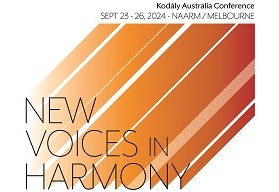Article by Catherine Lange, South Australia
The following is the first part of a series and focuses on developing a positive learning culture for boys in a mixed middle school choir. Part two will be published at a later date.
“When you start with your choir … teach the choir you’ve got,
but work towards the choir you want.” (Rodney Eichenberger)
Eichenberger’s quote above reminds me that as a teacher, whether generalist or specialist, the focus in the classroom and choir is on learning and learning growth for all students.
In mixed choirs, this means designing learning for every student, both boys and girls. While it is dangerous to generalise, in my experience boys and girls do tend to prefer different learning styles. Some boys tend to respond better to structured activity, clearly defined objectives and instructions, short-term challenging tasks and visual, logical and analytical approaches to learning. Some tend not to respond as well as girls to verbal, linguistic approaches.

As this is not true for every boy and girl, it is important to design learning in middle years’ choir that caters for multiple learning styles.
We need to consider what each student brings to the learning and their strengths, challenges, dispositions, culture and aspirations. Many would describe this as ‘good’ pedagogy , but I describe it ‘essential’ pedagogy if you want to attract, retain and engage boys in choir.
Research tells us;
“boys are more likely than girls to respond negatively
or overtly to irrelevant curriculum and poor teaching” 1.
If, like Richard Gill, you believe that “you can learn all of your musical concepts through the voice“2, it is important that boys as well as girls have equal access and opportunity to learning in choir.
In the past, people have asked me what concepts I use to engage boys in the middle years within a mixed choir. There are a few interconnecting concepts, I believe are essential as part of good choir pedagogy that have worked for me and these can be categorised under the headings of:
- Developing a Culture
- Structure of rehearsals
- Repertoire
- Student voice/negotiation in the learning process
In part one of this article I will focus on the importance of developing a culture that promotes learning.
Developing a Culture
At the centre of a successful mixed choir is a culture that promotes learning. Excellent middle years’ choral practices, processes and repertoire alone will never be enough for learning growth in choir. What matters is the culture that surrounds them.
Engaging all students in middle year choir, particularly boys is about creating a culture/environment that is collaborative, respectful, challenging, encouraging, safe and supportive. This is because peer relationships are particularly important to boys during the middle school years. Employing strategies to ensure that peer influences are positive is essential.
These include:
- starting children singing early and create a ‘singing school’ where everyone (boys, girls and teachers) sings and it is highly valued by the school community – this encourages them to continue participating throughout the middle years
- giving positive reinforcement: immediate and credible awards for quality work, increased effort and/or improved behaviour (for more read about Carol Dweck’s Mindset³ research)
- involving students in decisions about learning in choir (more on this in student voice/negotiating the learning process)
- ensuring that each choir member contributes and their contribution is valued ensuring a sense of belonging
- providing (creating) performances opportunities that builds confidence and when they are ready, give them a high profile performance in front of their peers that will ‘knock their socks off’
- promoting relationships within the choir through non-choral choir activities for example, excursions to hear performance, mid-year choir BBQ, etc
- ensuring that it is fun, exciting and personally rewarding
- timetabling choir so it does not clash with things that interest boys eg football, computing, etc
- modelling a love of singing and choir.
Part of creating a safe, non-threatening environment for boys within mixed middle years’ choirs is supporting them to understand the science of their changing voice and:
- allowing them to choose how high to sing, where to stand in the choir and providing a differentiated curriculum/repertoire
- giving them access to good male role models (older students, former students) to support and mentor them
- supporting and encouraging them to sing through the change
- providing formal and inform opportunities for feedback (more on this in part 2).
Teaching boys about a ‘head voice’, that is a good singing voice, compared to a ‘chest voice’ is important for them to understand. The art of ‘head voice’ singing is an important skill of them to understand, because boy’s have a most unique head voice (as treble singers), and once their voice changes they develop a strong chest voice. If they hear the sound and feel their head voice, when their voice begins to change they will feel different muscles being used to produce their sound and understand their new developing voice.
For more about the changing voice, I recommend Boys Keep Singing.¦
© Catherine Lange
References:
- House of Representatives Standing Committee on Education and Training 2002, Report on the inquiry into the education of boy: Boys getting it right Canberra, p. Xviii.
- Westwood, M 2015, ‘Schooling that sings’, The Australian, 27 October, p. 14.
- Mindset, Carol Dweck
- Boy’s Keep Singing. Professor Martin Ashley.



